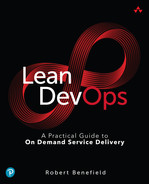Chapter 4
Friction
Only three things happen naturally in organizations: friction, confusion, and underperformance. Everything else requires leadership.
Peter Drucker
When it comes to service delivery, most of us equate friction with those elements that hinder our delivery speed and throughput. It is what drives so many of us to automate our builds and deployments, purchase cloud services, and adopt various Agile practices. But thinking about friction so narrowly can cause us to suboptimize, or worse overlook, everything else that is getting in our way of achieving the desired outcomes.
For John Boyd and Helmuth von Moltke, discussed in the previous two chapters, friction is what degrades our situational awareness and impedes learning. Boyd’s Energy-Maneuverability (EM) theory proved that even if you were faster and more capable than your opponent, you could still fail if you did not sufficiently adapt to changing conditions or incorporate learning effectively along the way.
Lean takes friction a bit further. In product and service delivery, Lean practitioners note that you can succeed at delivery and yet still fail if you are less effective than the competition at helping your customer achieve their desired outcome. To avoid this, team members in Lean organizations know to explicitly search for and try to eliminate anything that hinders or does not directly add value in any way that the customer can perceive, declaring it waste.
For Taiichi Ohno, who is credited with creating the Toyota Production System, waste takes three forms: pure waste (muda), overburden (muri), and irregularity (mura).
What is powerful about this approach is that it makes us openly question everything we do under the lens of how it contributes to the target outcome. The idea of removing friction and waste quickly reminds us that it is not how fast you can go that is important, but rather how far you can progress toward the target outcome. This different perspective on delivery forces us to challenge the status quo, driving us to continually experiment, learn, and improve to better achieve those outcomes.
Understanding Ohno’s Forms of Waste
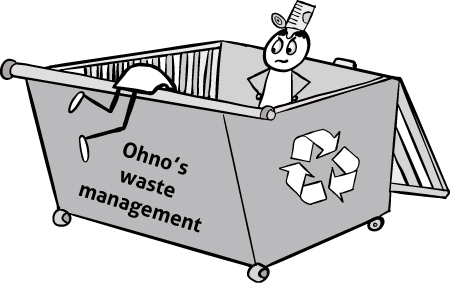
Figure 4.1
Ohno’s wastes.
Lean and the idea of targeting waste came out of the US government’s “Training Within Industry” (TWI) program,1 which was designed to improve productivity of war production efforts and overcome labor scarcity during World War II. One of its most valuable components, Job Methods (JM), specifically targeted waste reduction through continuous improvement.
1. https://www.lean.org/search/documents/105.pdf
Workers using JM were encouraged to constantly look for ways to improve the methods used to perform their work by thinking about why they were necessary and how they contributed to the intent behind the work. Were there unnecessary steps or details that could be eliminated? Could steps be rearranged or simplified to reduce mistakes or the time needed to complete a job? Workers who came up with improvements were celebrated and encouraged to share them widely.
These ideas were brought to Japan by US Army General Douglas MacArthur, the Supreme Commander for the Allied Powers in Japan after Japan’s defeat in World War II. He was in charge of reconstruction after the war and was eager to find ways to speed it up to improve the living conditions of the Japanese citizenry. One of the approach’s early adopters was Taiichi Ohno, a Toyota plant manager and later vice president of Toyota, who needed a way to help his struggling company compete against more resource-rich competitors like GM.
Ohno pushed these ideas to everyone across the company, from the worker on the assembly line to the executives at the top. To get everyone willing to pitch in to find ways to continually improve, he had to encourage them to change the way they viewed their jobs. Rather than just following instructions, they needed to continuously and critically examine everything that went into delivery. Anything that either got in the way of delivery or otherwise did not directly contribute to meeting the customer’s needs needed to be viewed as a form of waste that needed to be eliminated.
Ohno and the Toyota teams found that waste can take many forms. Being familiar with these types and their effects can help with identifying and minimizing their presence in your own ecosystems.
Muda (Pure Waste)

Figure 4.2
Muda is as bad as it looks.
Muda is the Japanese word for waste as well as uselessness, idleness, and futility. By definition it is an activity that the customer wouldn’t willingly pay for. Contrary to popular belief, the target isn’t to figure out how to do things cheaper. Rather, it is to identify and remove anything that doesn’t tangibly contribute to achieving the desired outcome.
Seeking out Muda is more than just finding useless things to eliminate. Muda can help us identify places where situational awareness has been lost, where customer outcomes have been misunderstood, or even where learning has been hobbled. It also gets us to better understand the underlying intent for all the things we are told we need to do in order to meet any legal, regulatory, or internal requirements that do not provide direct tangible value to the customer. For Ohno, these requirements were also a form of Muda. While they may be difficult to eliminate, it doesn’t mean that we cannot somehow minimize or streamline any friction they may create and still meet their intended purpose.
Shigeo Shingo, one of the creators of the Toyota Production System, helpfully identified seven types of waste in manufacturing. Over the years, an eighth was added (non-used employee talent), creating a helpful list for teams to use in their efforts to root out waste. To guide us on our journey I have created a useful analog in the DevOps world, which is shown in Table 4.1.
Table 4.1
Seven Types of Waste in Manufacturing and Their Corresponding Terms in DevOps
Manufacturing | DevOps |
|---|---|
Defects | Defects |
Overproduction | Overproduction |
Waiting | Systemic impediments |
Non-used employee talent | Overspecialization |
Transportation | Handoffs |
In-process inventory | Partially done work |
Motion | Task switching |
Excessive overprocessing | Excessive processes |
This may seem like a somewhat obvious list of things not to do. But it takes more than just declaring that you are not going to do them. It is important to understand why they happen, as well as how they degrade our decision making. Doing so should help you understand the power of many of the mechanisms, from Workflow and Queue Master to Service Engineering Leads and sync points, that I heavily rely upon both to make it obvious when they are occurring and to help teams eliminate them.
To better understand these types of waste, let’s step through each of them.
Waste 1: Defects

Figure 4.3
Even subtle defects can be deadly.
Whether they are bugs or shortcomings in a service, no one needs to be told that defects are obvious waste. They are a failure that gets in the way of a product or service performing as the customer needs.
Not only does no one intentionally create defects, no one likes to be known for doing so. The friction they create can slow down delivery in embarrassing and unexpected ways. As most teams are judged on how quickly they can deliver, this combination means that defects are often underplayed, hidden, or labeled as “features.”
Allowing a defect to fester only makes the situation worse. Defects found shortly after they are created are far easier to fix. The person who created a defect is far more likely to have enough context to know where it is located. As time goes on, context is lost, memories fade, and other changes may further obscure the root cause and thereby make it harder to find. Once a defect makes it into production, costs go up astronomically. Not only does this make it far more difficult to triage and fix, but now customers have likely been impacted.
Defect-ridden code is also hard to work with. It makes meeting deadlines far more unpredictable. Not only do defects need to be fixed, but they also make it easy to unintentionally create additional ones. Few people like working in such dangerously unpredictable conditions. Even the knowledge that an area has rotten code can make it incredibly difficult to attract and retain good delivery staff to work on it, making it that much more difficult to deliver effectively.
The best way to prevent defects from occurring is to understand their causes. As covered in Chapter 5, “Risk,” defects are the result of insufficient situational awareness of your delivery ecosystem. To demonstrate this, here is a list of the most common causes of defects:
Misunderstood requirements
Errors and poorly worded instructions
Lost or insufficient context within the problem space
Inconsistent or poorly structured and/or managed code, configuration, and/or data
A lack of, or hard to follow, dependency management
Poorly tracked or understood build and/or run environment management
Nondeterministic/nonreliable/nonrepeatable installation and rollback functions
Using an unsuitable or unfamiliar tool or language
Typos
Each one of these is an example of lost awareness. Some, like misunderstood requirements or lost context, are obvious. However, even more subtle causes like typos or tooling/language mismatches that seem minor on their face can cause very real, and often hard to find, problems.
Lean tackles this problem by trying to “mistake proof” the delivery line. It uses techniques designed to do this in two ways.
One approach is to design the system in such a way that it is impossible to make certain mistakes. Manufacturers do this regularly with tools and parts by creating a shape that can only be put together in one correct way. An example is the asymmetrical shape of an HDMI connector. In IT this can be done by creating tools that prevent dangerous commands or invalid configurations from being executed by accident. I cover some strategies for this in more length in Chapter 10, “Automation.”
The other way is to put in place mechanisms that make it far easier to spot mistakes and potentially hazardous conditions in the first place. Lean manufacturers use multiple techniques to bring immediate attention to anything abnormal or out of place.
One example is to use a clear marking such as color coding or symbols. Colors and symbols are great ways of providing a lot of information quickly with little overhead. Lean manufacturers use different colors for certain parts, trays, carts, and even places where tools are placed.
This simple technique is very helpful, and a familiar one for any heavy IDE (integrated development environment) tool user. I also use it heavily with color coding management interfaces and terminal windows between environments, color coding datacenter cabling and connectors, as well as color coding between different types of alarms and graphs. I have even worked with teams to “color code” tools, frameworks, and languages to the types of tasks that they are most suited for. Sometimes this “color code” is the use of distinct symbols or markings like stripe patterns in case someone is color blind. Using such coding mechanisms both encourages people to use the most appropriate option for the job and gets them to ask, and if needed debate, why a certain tool or technology is not favored for a particular job type.
Another example of a mechanism for spotting mistakes is what in Lean is called “stop the line.” In a Lean factory there will be Andon cords placed throughout the assembly line that activate an alarm to alert everyone of a defect. If the defect is not fixable immediately, the assembly line is halted. This exposes where a fault was found, aiding efforts to find the source, and prevents the failed product from moving further up the line where the fault can be concealed or create additional faults.
In IT such mechanisms are more difficult to put in place. We can and do stop builds and delivery pipelines when a failure condition is encountered. However, problems are not always obvious in the heat of the moment, when it is difficult to step back and see the whole. This is why I recommend having both a Queue Master, as detailed in Chapter 13, “Queue Master,” who can help find problems directly, as well as a Service Engineering Lead, as detailed in Chapter 9, “Service Delivery Maturity and the Service Engineering Lead,” who can help the larger team build the maturity to see more effectively themselves.
A shift toward such mistake proofing makes environments safe for teams to work in and repositions teams to view defects as a failure of the system that needs to be addressed to help all rather than as their own personal failure, which they might be tempted to conceal from others.
Waste 2: Overproduction

Figure 4.4
“But I only ordered one!”
You can have too much of a good thing, especially when if it is rarely, if ever, used.
Overproduction occurs when something is produced that has no paying customer. For manufacturers this excess results in inventory build-up that needs to be stored, discounted, or thrown away. This is obviously a Bad Thing To Do. Not only do you have to decide whether it is better to pay to store it or throw it away, the resources used to create it remain tied up in something that is not providing any value.
While IT overproduction is caused by many of the same forces as in manufacturing, namely a focus on outputs over outcomes, it is both far less visible and more destructive.
IT overproduction lurks in the form of unused or unneeded features, excess code, and unwanted activities that provide little demonstrable value. People may claim that customers want the unused features, but never bother to see if this is true or how it contributes to the overall outcome. Internal processes and tools may look useful but the output may be ignored or no longer provide any value.
What many IT professionals miss is that all of this overproduction is not just wasteful, but also introduces a lot of excess friction into delivery. Excess features and code might not be used but they have to be integrated, tested, deployed, and managed in production. If they are not, they can end up turning into dangerous landmines that can inadvertently destroy a company, as happened with Knight Capital (as detailed in Chapter 10, “Automation”).
Excess code and features also obscure our overall understanding of our ecosystem. They make it far more difficult to find problems, understand what code is and is not being exercised as customers use it, and figure out the best place to make changes and add features and functionality that customers actually do need.
To counter overproduction, I always try to make it obvious what the costs of doing it are to the organization. I track the extra support and maintenance costs, the added infrastructure costs, and the increase and variability of delivery times and defects it causes. I also try to capture actual usage patterns to make it easier to spot features that are rarely, if ever, used. This allows for the technical teams to hold a fact-based discussion with the business to ensure that what is being done is in the best interests of the organization and the outcomes of its customers.
Waste 3: Systemic Impediments and Waiting

Figure 4.5
“Please wait for the next available representative…”
Even with all of the focus over the years on new tools and processes designed to reduce delivery friction, we still struggle to get things done. Much of this is caused by a wide array of systemic impediments that IT teams manage to inflict upon themselves, either out of habit or through a lack of communication and understanding. Each one inevitably degrades our ability to make effective decisions.
While the most obvious impediments cluster around operational areas, many exist throughout the service delivery lifecycle. Common forms include frustrating bottlenecks, misalignments, and hard blockers that stop you from being able to make any progress at all until they are eventually removed. They result in delivery delays, rework, missed customer expectations, and frustration that can increase tension across the organization.
Identifying Systemic Impediments
The first step on the path to eliminating this form of waste is to first recognize the causes of systemic impediments. Frequently the cause grows out of a previous problem or goal that is no longer valid. Other times, communication issues and misalignments in goals or understood target outcomes create contention that hinders progress. Uncovering these causes and their costs to the organization can help bring attention to, and ultimately remove, an impediment.
To help you on your journey, here is a list of some of the most common systemic impediments:
Communication challenges: Distance, whether physical or organizational, limits timely high-bandwidth face-to-face communication. Instead, we are left to rely upon more lossy, out-of-sync communication mechanisms such as email and documents that lose context and can be misinterpreted in ways that reduce our situational awareness and cross-organizational alignment. As you will discover in Chapter 6, "Situational Awareness," the increasing globalization of IT also can introduce language and cultural background differences that can lead to further problems and create distrust.
Poorly configured work environments: In our increasingly virtual world, many organizations miss the value of a well-designed shared work environment. This is a place where team members can meet to work collaboratively with minimal outside interruptions. It also acts as an information store and sync point, creating a useful structure to capture and share information, as well as catch and correct misinterpretations. Without a shared work environment, whether due to limited space, geographical distribution, or a global event such as a health crisis, sharing becomes more informal and uneven. Without concerted effort to implement tools that improve information sharing, collaborative working, and conflict resolution, information can be lost, and trust can be hindered.
Poor environment management: Environment hygiene, from all the components that make up the service to the software, operating systems, patch levels, configurations, and physical and/or virtual layers of coding, testing, and operating environments, is important to keep track of and maintain. Any lack of hygiene introduces potential variation where situational awareness can be lost, thereby reducing the efficacy of decision making.
Poor code management: Code that is poorly written, commented, tracked, or updated makes working with it slow and error-prone. Supporting development tools and their usage, from code repository tools and structures to build and test tools and the artifacts they generate, are also important for code health. Anyone who has worked in a place with a large number of code branches and infrequently checked-in code knows how painful merging and integration is. This pain is caused because there has been so much disjointed change that no one person has the full context of the code. The gaps in awareness this creates across the team are difficult to close and also distract from the target outcomes you are trying to deliver.
Excessive tight coupling: Components, systems, and services can grow to become so interdependent upon each other that any change to one has a significant and immediate ripple effect on another. Tight coupling forces affected parts to be treated as a single unit. This reduces flexibility by forcing any changes in one to be treated as changes in all. It multiplies the effort required to deliver, manage, and troubleshoot. It can also increase the amount of downtime required to make a change, as affected parts cannot be swapped out or changed individually, as well as reduce the number of options available to easily scale those areas.
Competing objectives: Organizations can fall into the trap of having individuals or teams with different or even conflicting objectives. This can lead to disagreements, rivalries, and blocks that hinder progress. Not only do competing objectives impede business and create an impenetrable fog that obfuscates the strategic intent of the organization, they can divide and be heavily demoralizing to staff.
Waste 4: Overspecialization

Figure 4.6
Bill misinterpreted when they told him that his specialization would take him to high places.
When you face very deep and complex problems, having specialized expertise available to help can be very useful. Likewise, becoming the trusted go-to person for certain types of problems can even be ego-boosting. Acquiring those skills takes time and practice, with more difficult or rare skill sets often commanding premium compensation rates. This encourages people to specialize.
So what could possibly be wrong with this?
The problem begins with how specialists are deployed. When the skills are rare or expensive, many companies look to maximize their investment. They single out specialists, funneling all work requiring that expertise toward them. This creates problems that ultimately degrade situational awareness and weaken organizational trust and learning.
One such problem is the risk of separating work from its overall context. Specialists spend so much time working on tasks that fit their specialty that they often get left out of what is happening in the larger ecosystem, and with it the overall objective of the work. Similarly, those outside the specialty do not get enough of a view to understand what the specialist has done and why. This degrades feelings of ownership for everyone across the lifecycle, creating fertile ground for finger-pointing and blame.
Another such problem is the issue that the worker’s identity and value often become associated with their skill type rather than their ability to help the company achieve its target outcomes. The worker’s specialization is currency, and the rarer it is, the more the worker is worth. This disincentivizes specialists from sharing what they are doing with others for fear of endangering their value.
It is important to note that larger organizations are the most vulnerable to the specialization problem. The reasons are myriad:
Skill-focused hiring: Specializations are far easier to define as a need and hire as a position, making managers easily tempted to organize teams by specializations. Being narrowly scoped, work must then be passed from silo to silo to be completed. Hiring approaches that put applicants through specific tests that follow a narrow band of acceptable solutions often bias toward like-minded people. This makes teams more susceptible to tunnel vision and specialization “not invented here” groupthink.
Lack of ownership and insufficient understanding of the work: When there is a lack of ownership or insufficient understanding of the work, awareness of the larger ecosystem and responsiveness to events within it often break down. Work easily loses meaningful priority as it bottlenecks at handoff points between silos. Teams optimize based upon what is most expedient to them, even if it is at the expense of suboptimizing the larger organization. Temptation for finger-pointing and blame inevitably builds as work becomes blocked and problems that cross disciplines arise.
Fight against obsolescence: Rapid technology or strategy changes can render specialized skills obsolete. Incumbent specialists who see work shifting away from their area of expertise may attempt to stall or derail change, hindering an organization’s ability to adapt.
Lack of personal engagement and buy-in: The compartmentalization of duties creates a rigid and less stimulating workplace environment. Not feeling like a collaborative part of solving for an outcome can limit creativity and the adoption of new technologies and solutions. Limited management understanding of these underlying dynamics can further slow organizational responsiveness.
The best way for an organization to free itself of this waste is to continuously look for opportunities to minimize the need for specialization. One way is to avoid overly complex solutions that need deep specialization skills. Another is to rotate roles as well as find creative ways to regularly help members of the team cross-train each other.
Where specialized work is unavoidable, there are ways to reshape specialist roles and teams to minimize its drawbacks. The best is to embed specialists as subject matter experts in teams that own the end-to-end lifecycle. This model is similar to Spotify’s squads and guilds approach. Rather than performing all the specialist work themselves, the specialists can advise and train others to help ensure activities are done right. This not only improves flexibility by improving the size and liquidity of the pool of staff skill sets, but it creates an attractive incentive for employees to continually learn new skills. Specialists can still hone their skills, jumping into deeper challenges and sharing with other experts in a wider interest group. The wider exposure helps people become “T-shaped,” with both deep specialist knowledge in one area and broad competency across many others.
Waste 5: Handoffs

Figure 4.7
Handoffs.
Handoffs are a fact of life. Not everyone can always do everything all the time. Sometimes it may even be prudent, or a legal requirement, to intentionally separate responsibilities across teams.
Handoffs, however, introduce two challenges. The first is that people and teams do not always share the same set of priorities. When priorities differ, work can easily become trapped along a handoff chain. Whether a team is waiting for another team to complete a piece of work they need or a partially completed item is waiting to be picked up and completed, the delay it causes appears the same from the customer’s perspective.
The second challenge is that handoff and integration points become opportunities for information and context to be lost. The resulting flawed assumptions can lead to errors and rework, as well as complicate the troubleshooting of any problems that cross the handoff or integration boundary.
The most common form of handoffs are those between specialist roles and domain experts brought in to complete an activity. I have personally seen back-and-forth loops between DBAs and engineers or developers and testers that drag on for days or weeks.
Another common challenge is caused by the overly tight coupling between components as well as nonsensical splitting of responsibilities across teams. Ironically, such splitting is often done under the belief that more teams with fewer responsibilities will automatically result in faster delivery regardless of how tasks are divided up. This usually leads to dividing tasks at the very bottlenecks that lead to excessive handoffs.
It is important to understand where handoffs exist within your ecosystem. Workflow boards like those discussed in Chapter 12, “Workflow,” in conjunction with the Queue Master discussed in Chapter 13, “Queue Master,” can help you spot excessive handoffs. I also encourage teams to identify and discuss handoffs at retrospectives and Strategic Review sessions.
Encouraging staff to find ways to reduce handoffs wherever possible improves organizational responsiveness and flexibility. It also can improve situational awareness, as well as reduce errors and misunderstandings that result in wasteful rework.
Waste 6: Partially Done Work
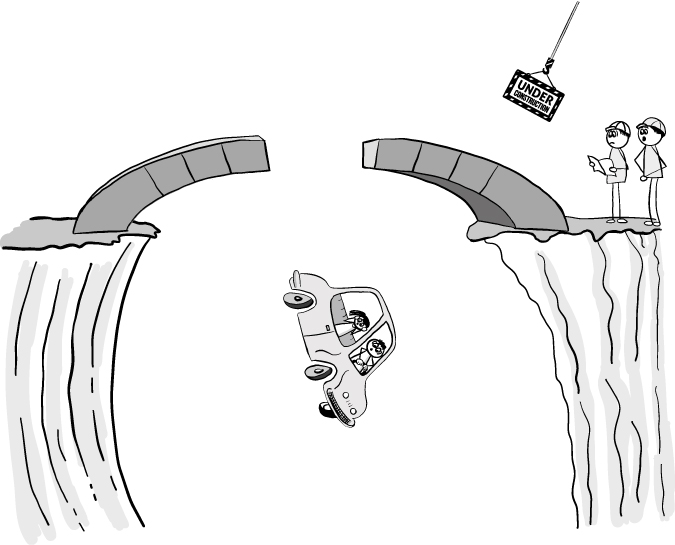
Figure 4.9
Partially done work.
In Lean, partially done work is called “work in progress” (WIP). WIP is anything that has had work done on it but is not deployed and providing value to the customer.
Partially done work, or WIP, is a common scourge of IT delivery organizations. It can appear everywhere across the delivery cycle, from modified code that has not been checked in, through unbuilt/unintegrated code, untested packages, unreleased software, released but turned off code, to partially completed operations tickets.
There are a lot of problems with partially done work. It is easy to focus on how it can create a lag in gaining value from the work, or how not checking in a big batch of code delays potentially useful feedback. Both are meaningful. But perhaps the worst problem with WIP is that it tends to create more work for people who believe what they are doing is making them more efficient.
Think through a time when you were juggling multiple pieces of work. Each time you cycled to the next item you had to put in some effort to regain context. Where did you leave it? In what direction were you trying to take the activity? Did something change while you were not attending the task that altered the dynamics enough that you have to course correct or even throw away what you have?
Another issue with temporarily losing context is that it creates an opening for mistakes. Dynamics can change in ways that you might not notice until it is too late. We can also misremember what was going on or what we were doing in ways that introduce unintentional defects or rework.
The best way to tackle partially done work is by making it and its effects visible. Workflow boards that show the amount of work in progress are one good form. This is also where Queue Masters are extremely helpful. They can spot not just when WIP is happening, but also some of the patterns that might be causing it. This can help teams find ways to work together to break their bad habits
One such common bad habit is our next waste: task switching.
Waste 7: Task Switching

Figure 4.10
Task switching.
Whether you are building, testing, or operating services, IT work requires a lot of deep concentration and building up context. Interruptions are hazardous for both. Yet in the desire to maximize output, we willingly accept frequent task switching as normal, whether in the form of interruptive fault troubleshooting or the sudden reprioritization of work.
It is easy to fall for task switching, and it often goes hand in hand with partially done work. Some love the thrill of racing off to be the hero in an outage firefight. Others feel that by having several activities on the go at the same time they are somehow more indispensable to the organization. Often an organization is particularly bad at prioritizing and tracking work, and every task becomes an opportunity for someone to lobby hard for it to be done immediately.
Switching between tasks is not just distracting, it fractures context, which slows our progress and degrades efficiency as partially done work builds up in the queue. Task switching also erodes our situational awareness, our ability to spot patterns, and ultimately our ability to learn and improve. Not only do we end up losing track of what is going on, but we risk losing touch with the outcomes that we need to accomplish. At best this can result in higher-priority items being delayed or neglected. At worst our ability to make sensible decisions fails.
Many IT teams, especially those with a heavy operational support element, resign themselves to widespread task switching. It is easy to believe that it is simply the nature of the job, but, as we will demonstrate later with the Queue Master role, restructuring the way that work hits the team can greatly reduce disruption. By being the entrance point for work, the Queue Master also can see across the ecosystem, noticing patterns and ultimately helping the team learn.
Workflow visualization techniques can also help uncover task switching, including lingering tasks and a build-up of work in progress. It is also important to actively look for and reduce the number of sources of task switching. As discussed in Chapter 13, “Queue Master,” I encourage Queue Masters to help the team investigate ways of restructuring long-running people-intensive tasks, as well as work that seems to flow in circles between teams or requires a great deal of back and forth.
Waste 8: Excessive Processes

Figure 4.11
“Why do I have to fill out all these forms to replace my keyboard?”
Processes can be helpful. They standardize the shape and direction of work to ensure a reliably repeatable outcome. If deployed and maintained properly, processes can reduce errors and rework. They also are good ways of capturing knowledge that can enhance the capabilities of the team.
However, you can have too much of a good thing. For IT, having and following the processes can become more important than the customer outcome, sometimes to the point where it is even declared as the objective that the customer is looking for. This is true even when the processes themselves do not seem to do much to improve delivery or service effectiveness.
Some of the worst process waste is done under the banner of “industry best practice,” even when it is clear that the process is hindering the business. Over time, this divergence in purpose can reduce an organization’s ability to respond in a timely and flexible way to the demands placed upon it. Learning and improvement seem to slow to the point where there is nothing significant that directly correlates to improved effectiveness and progress toward customer needs. Tensions and stress rise from increased frustration, workloads, and rework.
Excessive processes tend to develop one or more of the following attributes:
Inflexibility: IT lives in an ever more dynamic ecosystem. Customer and business needs can shift at an even faster rate than technology. The combination of condition changes means processes need to be continually reviewed, altered, and sometimes even eliminated in order to stay aligned. Inability or resistance to adapt processes reduces their efficacy and creates waste.
Excessively prescriptive: A useful process is typically a repeatable pattern that helps us understand the situation and navigate toward a successful outcome. However, excessively prescriptive processes can be so detailed that they become a mindless straightjacket that actively prevents people from adjusting to changing conditions. Such processes should be reviewed to determine whether the process is a workaround hiding a larger problem.
Demonstrate little to no discernible customer value: Some processes are put in place with the best of intentions. However, due to either habit or misunderstanding of the actual need, they struggle to provide any appreciable value. These processes are typically poorly constructed or are ill fitting for their deployed environment. Sometimes they have been taken verbatim from another environment or official list of “best practices.” For instance, one company required physical signatures for certain change procedures. There were no legal or regulatory requirements for the procedure, and later I found that the only reason it was there was because the process had been copied from a company that did have such requirements.
Such processes should be reviewed to dtermine what problem they are trying to solve and whether the problem exists and needs solving in the target environment. If it does, the process should be altered to make the intended desired value far more apparent. If it doesn’t, the process should be thrown out. It is far safer to have no process than to shoehorn in one that is not fit for purpose.
Execution-knowledge mismatch: Sometimes a process ends up being executed by people who either do not understand the underlying reasons for it or lack the knowledge, awareness, or skills required for executing it. IT organizations are often filled with such processes, and they don’t just occur at the junior support technician level. In fact, in my experience they are most common where a process requires sign-off by senior management, like change board approvals and official governance processes. The lack of sufficiently shared situational awareness degrades the approver’s ability to effectively execute their intended procedural duties. It can be caused by ineffective internal communication flows as well as poorly structured information.
When mismatches happen, it is imperative to quickly find out how they have developed so they can be rectified. Is there a more appropriate way of achieving the intent behind the process? Perhaps the process can be executed at a level where the right situational awareness exists, or the quality and flow of information can be improved such that the approver can effectively perform his or her duties.
Regularly broken or circumvented: Sometimes processes seem to be regularly broken or circumvented. One very common one is breaking a purchase into a lot of small transactions in order to work around a very slow process for anything over a particular value. Another is reusing old code or systems to avoid having to spend lots of time porting to some substandard “official” technology.
These are all symptoms that a bigger problem exists. Rather than resorting to strict enforcement, the process needs to be reviewed to see why it is not followed. It is possible that the process is overly cumbersome, doesn’t match actual conditions, or that its value is not understood by those who should be using it. Occasionally, much like the fact that certain statutes require that some financial transactions use fax technology, the process is simply no longer needed.
Each of these symptoms is a good indicator that you have excessive processes. It is important to review processes regularly, whether or not there are obvious signs of problems. I usually encourage teams to look at whether any processes appear problematic or questionable at regular cycle sync points like retrospectives and strategic reviews, as discussed in Chapter 14, “Cycles and Sync Points.”
Good processes need to clearly contribute to the larger objectives, the ones that the customer cares about. Processes that do not do that in the most effective way need to be changed or removed entirely.
Muri (Overburden)
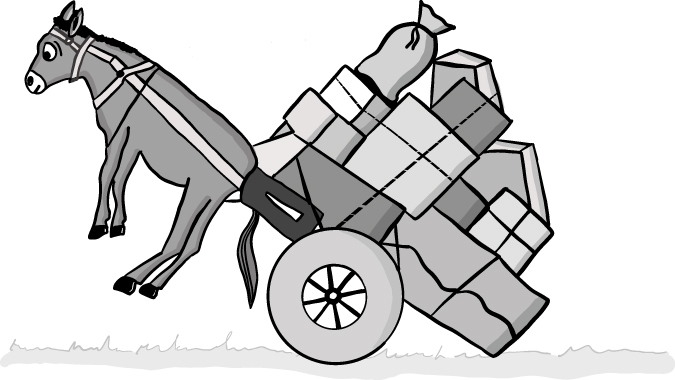
Figure 4.12
“Surely there is room for just one more package in the release!”
Not every form of problematic friction is a form of “pure waste.” One such form is known in Lean as Muri, or overburden.
Scientific Management and cost accounting have long trained managers to think of inputs as sunk costs that need to be fully exploited in the name of efficiency and cost management. People with such a mindset believe that anything less is “waste.”
Such overburdening is never good, and it can take many forms. Most people concern themselves with overburdened systems and machines, knowing that their reliability degrades with each little push beyond what is reasonable. However, there are two often overlooked forms of overburden that can damage our ability to deliver and make effective decisions: overburdening people and overburdening releases.
Overburdening People
Overburdening people is extremely common. Not only are managers frequently cajoling their staff to give it their all, many who are ambitious or nervous about losing their jobs also want to be seen going the extra mile. But such behavior is actually quite risky. There are, of course, the challenges that it can lead to burnout and leave little slack to compensate for any problems that occur. However, a far more pressing issue is the way that it damages decision making.
When people are stressed or otherwise overburdened, they unconsciously narrow their attention to only the most critical aspects of the immediate task at hand. This forced myopia keeps the person from becoming overwhelmed, but at a significant cost.
Less awareness makes it far more difficult to notice important facts or changing conditions across the ecosystem, limiting people’s ability to learn and adjust. Research suggests that overburdened people are less productive and make more mistakes.2 Overwork also can cause those affected to miss important decision points along the way.
2. https://www.uclan.ac.uk/news/tired-and-overworked-employees-pose-huge-risk-to-business-data
Another fact that many miss is that even one overburdened team member can affect decision making for the entire team. An overburdened team member is likely to feel too busy to share what information they do have, weakening the awareness of those around them. They are also more prone to miss deadlines and important sync points, and are typically far less willing to “waste time” reviewing a situation or aiding their own learning and that of others. They don’t have to step back, consider the big picture, and find a better approach.
I run into overburdened people all the time. The worst part is that they are usually those that an organization can least afford to lose.
So how do you fix overburdening your teams?
It starts by making sure that the overburdened people attend the sync points, especially retrospectives and strategic reviews. They will try to refuse, which is when managers and teams can stage an intervention, sometimes even using a review session as a way to figure out how to redistribute or otherwise reduce workloads. It is also good to rotate those people to other areas that are new or different to them within the team’s scope. Their insight will usually be valuable, and it will give them time to step back and realize for themselves the damage they were causing to themselves and others in their efforts to help the team succeed.
Overloading Releases
Having occasional big releases consisting of lots of changes bundled together can seem like a good thing. It gives developers more time to work on meatier problems and gives testers more time to test. Operations people like the fact that there will be fewer release interrupts to worry about, while for customers a surge in new features can make a new release seem compelling.
So why are big releases a bad thing?
Rather perversely, many who favor the big release approach over having more frequent smaller ones usually end up increasing the very risk and delivery friction that many claim they are attempting to avoid. For starters, having fewer releases doesn’t necessarily equate to less risk. In fact, bundling many changes means a thicket of new and different interactions. This creates a thick fog that obscures everyone’s situational awareness. Which of the many changes might be the root cause of a new problem? It could be one or the interaction of many. If developers haven’t fully thought out how each change might interact with others or, worse, if changes were made by several different teams, it could make troubleshooting and fault resolution far more difficult and time consuming.
Having fewer releases doesn’t really help reduce delivery friction, either. Giving developers longer to work on features can encourage long-lived branches and fewer check-ins. This reduces transparency and can result in a painful integration problem down the road. It also lets developers off the hook from thinking defensively about changes and how they might interact in the ecosystem if they go live before they are complete.
Longer release cycles do not help testing, either. Shorter cycles require really understanding what is of high value to test. They also create an incentive to invest in improving test cycle times, allowing the organization to get more feedback more frequently. Longer cycles encourage generic testing with poorer focus and longer feedback cycles. This results in a poorer understanding of the health of the code, and often results in releases going live with lots of known bugs.
The same goes for governance processes. Those used to working with large releases often fool themselves into believing that the only way any organization can have robust governance is to require many checkpoints full of reviews and detailed documentation in order to spot and mitigate potential risk. However, having necessarily heavy governance processes can actually make it more difficult to manage risk. Nobody likes having to justify everything they do, and the documentation process can be tedious and feel wasteful for everyone involved. When change tracking is limited and governance boards are run by managers who are not deeply technical or into the detailed minutiae, many smaller changes are simply missed or obfuscated in the name of expediency.
There is also a time penalty. Change happens in more than software. People, usage patterns, business requirements, and regulatory requirements can all change, sometimes unexpectedly. More time means more opportunity for these changes to affect the operating environment of the service. A release that reflects the earlier conditions from when the project was started may be unsuited for current needs. Holding onto changes longer also delays customers and the business benefiting from their value, if their value isn’t eroded away by changing conditions.
What to do?
All of these types of Muri can be avoided by looking at how work flows through each part of your system. As discussed in Chapter 12, “Workflow,” visualizing workflow through effective use of Kanban boards and Queue Master rotations can go a long way to help spot problematic bottlenecks, including long wait times, deep queues, and lots of work in progress.
Another useful measure is to look at code repository structures and statistics, as well as build, test, and deployment statistics. Does work get trapped on long-lived branches? Are certain tasks always handled by a tiny minority of the team? Are there long integration and test cycles with complex conflicts and seemingly intractable long-lived bugs? Do deployments touch a lot of different areas? Is it expected that there will be unstable periods after a production release?
Understanding flow and Muri can help us create a sustainable balance that promotes the very awareness and learning needed to make better decisions and achieve our target outcomes.
Mura (Fluctuation and Irregularity)

Figure 4.13
“Well, this isn’t much fun!”
Mura means unevenness, irregularity, or lack of uniformity in Japanese. For manufacturing, unexpected shifts in customer demand, uncontrolled variability in products, unreliable equipment, and poor training can cause irregularity or fluctuation that can lead to organizational stress, quality problems, unhappy customers, and waste.
IT also suffers from a variety of forms of fluctuation and irregularity, from sudden demand spikes to unexplained loading and configuration drift that hinders service delivery function and performance. This has become an even greater problem as IT services have become more demand based. Not only have service stacks become far more complex, potentially causing delivery and operational workload fluctuations, they are also shared, meaning that problems that once were localized, such as misconfigurations or instance failures, can have a widespread effect. Also, with shared usage, user uptake and usage patterns can compound in unique ways. This can lead to wild load fluctuations that can occur with little to no warning. These can cause large, complicated problems that can cripple a service and be challenging to rectify.
The biggest mistake that people make is believing mura is both inevitable and unavoidable. It is not. Mura itself is caused by a situational awareness gap interacting with friction points in the ecosystem. This unknown can be caused by anything from an externally driven demand to an irregularity within the ecosystem itself. The unexpected fluctuation or irregularity only causes a discernible problem when it catches on one or more friction points it encounters along the way.
Another interesting aspect of mura is that the way we respond to the problem can heavily influence the severity of the outfall from the variation. In fact, it is one of the most common places where our instinctive reaction to the problem is likely to cause a further cascade of irregularity and friction that can compound the damage caused.
As we will see, the best way to eliminate mura is to aggressively find and close situational awareness gaps wherever possible, all while simultaneously removing friction points and exploiting bottlenecks in the ecosystem.
To better understand, let’s take a deeper look at the two most common patterns: unexpected demand variability and unmanaged variability.
Unexpected Demand Variability
We are all familiar with the concept of fluctuating demand. Demand inevitably ebbs and flows throughout the day, week, or even year. Most variability is only noticed when a bottleneck, such as a store checkout queue or a traffic backup, creates some sort of noticeable delay or failure. Such variability, while unpleasant, is tolerable when it follows predictable patterns that we can make adjustments for in advance to ease the pain.
It is a very different story when demand shifts unexpectedly. Whether it is a lack of toilet paper or a suddenly overloaded web service, customer frustration builds to the breaking point as suppliers scramble to respond and adjust.
For IT, demand-triggered variability is often a sign that the delivery arm has somehow become disconnected from the customer and their target outcomes. This loss in awareness makes it difficult to foresee even gradual changes until they cause a real problem. Crisis then ensues when the organization’s response hits friction that makes it difficult to adjust sufficiently to deal with the situation.
These sorts of awareness gaps tend to have two common causes.
First, in some instances, Sales, Marketing, Product, and Support teams that do have regular contact with the customer want to reduce potential distractions and have more control over managing delivery team priorities by acting as a proxy between customer and delivery. While the reasoning can be sound, it often leads to information delays and context gaps. The end result is the delivery team seeing a stream of jobs that lack much of the important context of the actual outcome desired or the obstacles in the customer’s way in reaching it. Not only do they have no easy means to build an understanding, they have no way of catching any mismatches that develop. This leaves a system full of awareness gaps and friction points where variability will thrive.
Second, awareness gaps more commonly form around the fragmentation of organizational silos. Looking at the ecosystem from their fragmented perspective, neither the business nor the delivery sides can be fully aware of the customer or of the dynamics that drive behavior in their environment. This is never a great spot to be in, but really becomes a serious issue when one or both sides fully believe they have the true picture and that any misalignments are just noise or the other side’s fault. The problem gets compounded by a lack of understanding of the health of the delivery side or its ability to handle demand shifts.
In both cases, when the crisis hits, a cascade of problems erupts. Teams can become overwhelmed (Muri) or defensively fragment along functional lines (Muda) to avoid blame. The stress slows everything down, mistakes increase, and the organization’s ability to deliver becomes severely disrupted.
Even in the most minor cases the team will not completely recover. Previously promised work will be missed or suffer quality issues. Unless actively countered, trust will further erode while the facts of what happened are hidden or obscured for fear of blame. This further degrades situational awareness and puts severe limits on organizational learning and improvement. The stress of the event can also leave people stressed and create bad feelings across teams, adding further delivery friction.
This may sound bad, but the problem rarely ends there. The awareness gap that caused the initial crisis often makes us misread what happened as a pure resourcing issue. Our instinctual response pushes us to make further inappropriate decisions that only exacerbate the actual problem. The C-suite is particularly vulnerable to this. In most cases the reality on the ground has been obfuscated by the streams of cheery reports C-suite members receive and heavily managed interactions they have with their subordinates, meaning that often they too have lost their situational awareness.
Let’s take a look at what happens and why we often make things go from bad to worse.
The Bullwhip Effect

Figure 4.14
“Snap!”
A variability-triggered crisis can seem very scary. When first reactions prove to be insufficient and everything appears to be sliding further into chaos, it is tempting to overreact and throw resources at the problem. This can be in the form of more infrastructure, more people, additional project time, extra features, or even more teams and software.
On the surface, this response makes sense. More servers, software, and hands available to throw at a problem may feel like insurance, even if it increases costs and complexity. But the extra padding does little to solve the underlying problems. Awareness is, at best, no better. In fact, the extra resources may simultaneously increase friction and degrade awareness. This can further compound the original problem and provide the necessary fuel to create a bullwhip effect.
The bullwhip effect is a classic supply chain friction problem. It begins with a sudden unexpected shift in demand. This shift can start from a steady state or, as happened during the COVID-19 pandemic, be preceded by an abrupt demand drop that forces production to be dramatically reduced to a lower baseline. As you will see, the problem is not that there has been a demand shift but how much friction an organization needs to overcome to spot and adequately adjust to it.
In IT these shifts typically take the form of load spikes and feature demand. IT teams respond by frantically trying to increase supply. For capacity, it might be panic buying and setting up new capacity or stealing it from other areas. For code, it could be hiring lots of developers or outsourcing large swaths of development.
As demand hits the supply chain, the bulge hits friction points on the delivery side, creating a ripple effect of stress and delay. The more time and focus that growing capacity takes, the more the pressure to complete will build. Such stress inevitably will compel those in the supply chain to act without spending sufficient time investigating what is driving the demand, how long it might last, or the repercussions of their actions on other elements of the ecosystem.
This is where the real damage kicks in.
Once the situation has become stabilized, delivery friction now makes it expensive and painful to change direction and bring things back to normal. This forces the organization into an untenable situation. If you ordered new resources (servers, people, software, etc.) you still need to take delivery even though they may be of little use. If you stole resources from somewhere else, you need to find a way of dealing with those ramifications. If you temporarily outsourced much of your development, you will need to figure out how to cost-effectively understand the state of the code and how best to manage and support it moving forward.
The worst part of all of this is that there may be so much built-in friction that reversing any decisions made or mitigating the damage they might cause is often difficult or impossible. Budgets and project schedules are often blown, sometimes in ways that incur high ongoing costs, with little to show for it.
Another damaging element of the bullwhip effect is that, despite creating a whole new set of issues, the underlying problem that created the initial cascade remains unsolved. Until those friction and awareness gaps are addressed, there is nothing to stop this cycle from repeating over and over, wasting ever more precious resources as customers continue to feel neglected and underserved.
Unmanaged Variability
Not all variability is sudden or demand driven. It can just as easily live in our services and the wider environment. It might be caused by a slightly different configuration over here, subtle differences in understanding over there, customers with divergent usage patterns or needs, or even aberrations caused by differences in the ordering of events. These quietly build like so many layers of paint and grime on a wall, obfuscating the real state of the ecosystem in ways that make it increasingly less predictable and reproducible.
Rising complexity in technology stacks, along with the growing adoption of virtualization and containers, has only increased the number of opportunities for variability. Everything from varying hardware components in computers, differences in compiler-generated byte code and software patch version, to unseen resource contention that varies the sequence and timing of operations can cause subtle yet important variations in behavior. Even differences in client endpoints and the way they access services can have a noticeable effect. Increasing the number of moving parts only adds to the risk.
The growth and fragmentation of organizations hasn’t helped matters. Organizational silos can create drift in interpretations and implementation details. It only takes one misunderstanding between individuals or teams to create havoc that can easily disrupt the service.
Despite this growing complexity, many in IT seem to approach these challenges optimistically unaware. Those who do concern themselves with unmanaged variability often mistakenly believe that it can be fixed simply by forcing everyone to follow prescriptive processes.
The Snowflake

Figure 4.15
Snowflakes are all unique and fragile in their own special way.
As children we are told that every snowflake is different. This makes its fragile beauty special because it is both one of a kind and ephemeral. Few would suggest that these are qualities that we want in our IT services. Yet, the ways in which many organizations build and manage environments make snowflakes in IT frighteningly common.
In 2012 Martin Fowler wrote a blog post that coined the term “snowflake server.”3 Snowflakes are server and software configurations that have organically grown and changed over time to the point where it is nearly impossible to exactly duplicate them. They can happen anywhere, from server and data configurations to external environment factors such as hidden resource contention in virtualized or containerized environments.
3. https://martinfowler.com/bliki/SnowflakeServer.html
More often than not this drift happens through special “one-off” tweaks, such as manual modifications to fix a problem and get things working. Other times the drift is caused by poor packaging and patching that leaves installation and update detritus scattered about. With the “job done,” people often forget about the details of what or how it was done. As one-offs build, it becomes harder and harder to figure out everything that makes them different from what we think they should be. They become increasingly unpredictable and dangerous, sometimes to the point of paralyzing improvement and putting the business at risk.
Those who are faced with having to reproduce unknown one-off configurations often try to overcome the problem by simply imaging the disks of the deployed instances bit by bit. But as Fowler notes, such hacks not only perpetuate the buildup of cruft, they also do nothing to ensure consistent and understandable behavior.
Minimizing Mura
The best way to minimize mura is to look at tackling its root causes. That doesn’t mean trying to avoid shifts and change. Ecosystem change is unavoidable. However, we can do something about minimizing problematic friction.
The first and most important thing to do is eliminate any avoidable gaps in situational awareness throughout your environment wherever possible. Regardless of whether we are a junior staff member or the CEO, we all unintentionally do things that can create false assumptions, communication breaks, and misunderstanding.
The following are some questions that you and the rest of your team might want to consider asking yourselves in an effort to minimize mura:
Do organizational silos exist and, if so, are they necessary? If they do and they are somehow unavoidable, can software and infrastructural dependencies that cross team boundaries be minimized? Can work be restructured to improve transparency and communication across organizational boundaries in a way that improves situational awareness, collaboration, and trust?
Have you eliminated all “single points of failure”? These are places where only a small number of people know an element within your environment. This could be code, configuration, how to deploy, how to use, how to troubleshoot, or anything else that is important within the service lifecycle. The best way to test this is to see how well tasks can be rotated among people in the team. If only a small fraction can do the work, they should pass on their skills so that others can do it as well as they can.
Does every API have an owner? If so, do the owners ensure that API compatibility and coupling best practices are in place to allow for changes to be made by one team with minimal impact to others?
Have similar things been done at the data level, where every piece of data has an owner, and the data quality, rate of change, and importance are understood? Have dependencies been minimized wherever possible so that they can be easily managed?
Are there ways that you can authoritatively know what is out in your environment, including how everything is configured?
Can everything be easily reproduced exactly without resorting to imaging?
Can software be deployed and configured atomically?
Are differences between deployments and versions captured, known, and understood?
Do you avoid uncontrolled one-offs? The best way to test this is to check that every release and patch is fully version controlled, all changes made by scripts are fully transparent, logged, and auditable, and if shell access cannot be eliminated, that write and execute privileges are both minimal and fully logged and auditable.
Minimizing variation wherever possible does help. Unfortunately, eliminating all of it is nearly impossible. Your services may depend upon shared infrastructure and services that you neither control nor have full transparency into. You may be dependent upon technologies and data that you do not have direct access to examine, or your customers may be unwilling to reveal enough about what they are doing and why to help you forecast patterns ahead of time. You may even have legacy “snowflake” servers, software, and processes. One thing you can do is design your environment to be resilient to chaos. I refer to this as the “Defend against the Madman” approach.
The way this model works is simple. If your service has an element that lacks sufficient transparency, imagine that it is in the hands of a madman and try to figure out the worst damage that that element can do, and how it might do it, to the parts of your service that you know. If it is a cloud service, imagine someone taking resources away randomly or loading things down where clock ticks become distorted. How would you track its effect and engineer against it? What sorts of user activity could be dangerous, how could you spot that activity, and what could you do to manage the situation? If the component or service lives in a snowflake configuration, imagine a malicious and crazed person running through the halls and in the data center with an ax. What could that person destroy that would be difficult, painful, or just plain impossible to replace or recover from? Is there a server or disk array that is really important and difficult to replicate? Are there particular people who have knowledge or skills that no one else possesses? As equipment goes offline, what are users experiencing with the service? How can you make any friction visible, and what can you do to mitigate it?
All of this probably sounds improbable, but it does the job of breaking the overly optimistic happy-path approach that seems to pervade the IT industry. If you take it seriously, you begin to approach challenges defensively, thinking through failure modes and how variability might strike. This also moves us closer to reducing the level of variability that we, and ultimately our customers, are exposed to.
This concept is hardly new in our industry. It goes to the root of much of the thinking behind test-driven development (TDD), where you write the tests first that capture the various use cases that your code might eventually be exposed to before you write your code. This helps with thinking through the problem set before you code rather than being colored by the way you put it together after the fact.
See the Whole
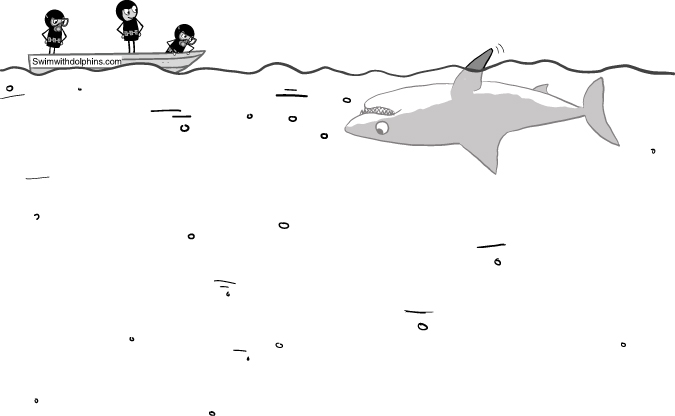
Figure 4.17
“I think that dolphin over there wants us to dive in and play!”
As you might imagine, it is rare for most sources of friction in the service ecosystem to neatly fit in one category or have one simple root cause. Often, they layer on top of one another, creating a tangled mess of dysfunction.
For this reason, Lean embraces examining the whole value stream from the time an order is received until a solution is delivered to address it. Leaders are encouraged to walk the floor (“go to the Gemba”) to look at the end-to-end flow with their own eyes. They do this not to tell people on the floor how to do their jobs, but to help find the impediments that reduce awareness within the workspace as well as across the line.
To improve awareness and reduce bottlenecks, the structure of work in Lean organizations tends to be more fluid, with fewer sharply defined roles. In Lean Manufacturing, people are encouraged to work together to make adjustments to the structures of their work stations and their way of working to improve flow and reduce errors. Information can flow naturally, allowing workers flexibility and awareness that helps shape meaningful continuity between their work and the end product.
Lean organizations also reach out to customers and suppliers in order to understand and work together toward achieving the desired outcome. When Toyota decided to enter the US minivan market, they had their design team drive around the US in a minivan to understand the needs and desires of the market. Similarly, they drove European luxury cars in Europe and the US before embarking on Lexus. Toyota also regularly works with suppliers to help them understand and adopt Lean practices, knowing that their improvements will help both Toyota and their customers in the end.
Summary
Focusing only on improvements that increase delivery speed and throughput does little to ensure you and your team deliver effectively. Friction “wastes” in your delivery ecosystem can damage responsiveness and increase team workload, all while reducing your ability to deliver the outcomes that your customers expect and your organization needs to be successful.
As you will see in the next chapter, gaps in your situational awareness caused by friction and your inability to understand your delivery ecosystem also have a significant impact on delivery and service operational risk in ways that reduce the efficacy of traditional IT risk management mechanisms.
